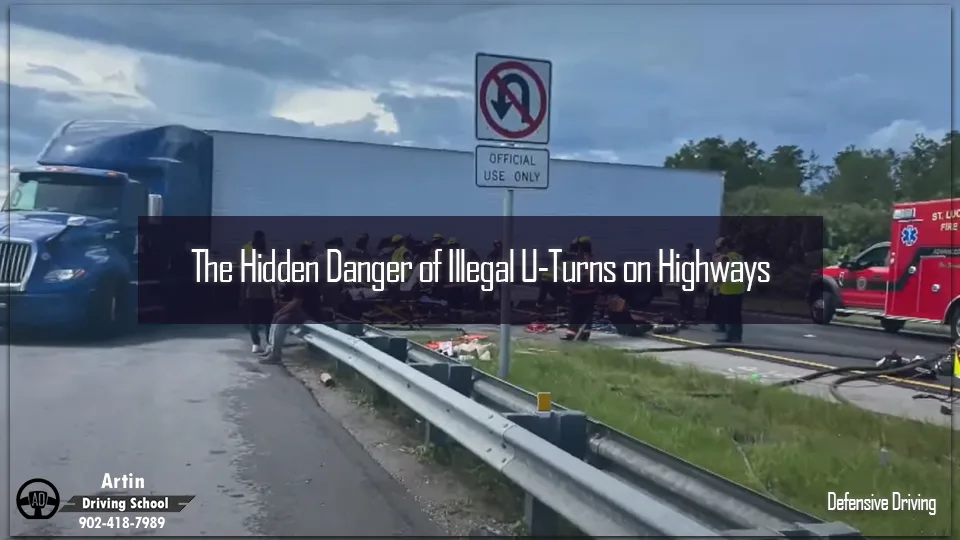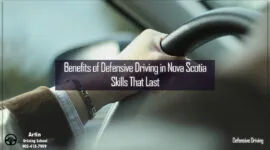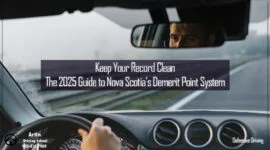Table of Contents
The Hidden Danger of Illegal U-Turns on Highways, Especially for Tractor-Trailers
The consequences of illegal U-turns can be catastrophic for any driver. In a tractor-trailer the risk multiplies, because a long trailer can swing out and block live lanes in seconds, leaving approaching traffic with almost no time or space to react. This guide explains why these manoeuvres are so dangerous, what Nova Scotia’s rules and signs require, and how both professional and everyday drivers can avoid the worst-case scenario.
A teachable moment from a recent U.S. case
In August 2025, Florida troopers reported a fatal crash after a semi-truck attempted a U-turn at a median opening marked for official use only. The trailer ended up broadside across live lanes and a minivan struck it, with tragic results. While that incident happened in the United States, the lesson applies here too, because the physics, the sight-lines, and the way controlled-access roads function are the same. If you miss your exit on a controlled-access road, the safe choice is to continue to the next interchange and turn around there. Cutting across a median or trying to improvise a turnaround introduces multiple risks in seconds—exactly the kind of chain of events that shows the consequences of illegal U-turns.
Consequences of illegal U-turns for tractor-trailers
Controlled-access roads are designed to separate opposing streams of traffic. A tractor-trailer trying to reverse direction across a median defeats that design and creates several hazards at once:
- Trailer sweep across lanes. A 53-foot trailer can swing sideways during a tight turn and quickly block one or more lanes, becoming a solid barrier for oncoming vehicles. This is one of the most severe consequences of illegal U-turns in heavy vehicles.
- Long stopping distances. At highway speeds, heavy vehicles need far more distance to stop than passenger cars. If a trailer suddenly blocks the roadway, drivers behind may not have the space to avoid impact even if they react immediately. Safety guidance for large trucks underscores the need for a generous space cushion.
- Large blind spots. Tractor-trailers have significant “No-Zone” areas along both sides, close in front, and directly behind. Other vehicles can vanish from mirrors at the exact moment precise judgement is needed.
- Crossovers not built for the job. Many median openings exist for emergency and maintenance operations, not for long combination vehicles. A rig can jackknife, high-centre, or become stuck partially across lanes, worsening the consequences of illegal U-turns for everyone approaching.
- High driver workload. A U-turn demands steering, gear changes, and gap selection while traffic is moving in both directions. Under stress, the chance of misjudgement rises quickly.
What Nova Scotia law and signage require
Nova Scotia’s rules focus on visibility, signage, and safe places to turn around:
- Visibility matters. Turning around on a curve, near the crest of a hill, or anywhere your view is restricted within a safe distance is prohibited.
- Obey traffic control devices. If signage says “No U-turn,” do not turn around there. The same principle applies to any regulatory sign that restricts movement.
- Use proper interchanges. Do not cross at an interchange to reach the opposite-direction exit ramp. Public turnarounds on controlled-access facilities are provided at interchanges designed for that purpose.
- Respect median crossovers. Openings in the median are for emergency and maintenance vehicles unless clearly signed for public use.
In short, if you miss an exit on a controlled-access road, continue to the next interchange and re-route safely. Median openings are off-limits to the public unless signage explicitly says otherwise. Following these simple rules prevents most of the consequences of illegal U-turns we see in serious crashes.
Best practices for professional drivers and fleets
A zero-tolerance stance on U-turns along controlled-access roads is simple and effective. Practical steps include:
- Never use restricted crossovers. If you miss an exit, drive to the next interchange. Make this a written policy for company drivers and contractors.
- Plan the route. Use truck-specific navigation and plan legal turnaround points ahead of time, including contingencies for closures or detours.
- Reinforce No-Zone awareness. Post blind-spot diagrams where drivers can see them and include them in regular training.
- Manage space and speed. Maintain generous following distances and reduce speed early near ramps, curves, and construction zones.
- Coach with data. Telematics, GPS breadcrumbs, and random dashcam reviews help you coach early and prevent risky improvisation.
How everyday drivers can reduce risk around trucks
- Give trucks room. Do not linger beside a trailer and leave more space when merging in front of a heavy vehicle.
- Avoid blind spots. If you cannot see the truck’s mirrors, the driver may not see you. Drop back or pass promptly and safely.
- Expect wide, slow turns. Do not squeeze along the sides of a turning truck.
- Follow the rules for controlled-access roads. If an opening is marked for official or emergency use, it is not for general traffic. Using it can trigger the consequences of illegal U-turns that you are trying to avoid.
Local context, controlled-access roads and changing weather
Nova Scotia’s divided corridors include sections with limited sight distance, wildlife movement, and fast-changing conditions. Winter brings reduced traction and longer stopping distances. Rain and fog can cut visibility. Under these conditions, any attempt to reverse direction across a median or near an interchange magnifies risk—for the truck driver and for everyone approaching.
Quick checklist to avoid high-risk U-turns

- Missed the exit? Keep going to the next interchange.
- Not sure about a crossover? If it is not clearly signed for public use, treat it as off-limits.
- Low visibility? Increase following distance and delay complex manoeuvres until conditions improve.
- Running late? Do not try to recover time with risky turns. A few extra minutes to the next exit is the safer choice.
FAQ
No. The rules focus on where visibility is limited and what signs permit. On controlled-access roads, public turnarounds are provided at interchanges. Median crossovers are generally for official use unless clearly signed otherwise.
A long trailer can end up broadside across live lanes. Heavy vehicles need much more distance to stop, and blind spots make gap selection difficult. Together, those factors create a high-severity crash risk.
Continue to the next interchange and turn around there. If traffic or weather is poor, slow down, increase your following distance, and allow extra time. Remember, avoiding risky improvisation prevents the consequences of illegal U-turns that make headlines.
Final words
Want practical techniques that prevent last-second decisions and risky manoeuvres? Take our provincially approved defensive driving course. Build a calm, repeatable system for safer choices on every trip. For official rules and signs, see the Nova Scotia Driver’s Handbook.
The information provided on this post is for general informational purposes only and is not intended to serve as professional advice or guidance. While Artin Driving School strives to ensure the accuracy and timeliness of the information shared, Artin Driving School makes no guarantees, warranties, or representations regarding the completeness, reliability, or suitability of any content posted.





